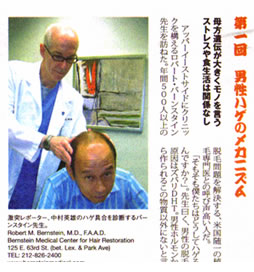Q: I am considering a hair transplant and would like to have the procedure and not be overly obvious about it. What are my options in hiding or concealing any redness after a week or so after the hair restoration. — R.T., Manhattan, NY
A: There are a number of factors that can make a hair transplant obvious in the post-op period. These include the redness that you are asking about, but also crusting and swelling.
Redness after hair restoration surgery is easily camouflaged with ordinary make-up. At one week post-op, the grafts are pretty secure, so that make-up can be applied and then gently washed off at the end of the day. Since the recipient wounds are well healed by one week, using make-up does not increase the risk of infection. At 10 days after the hair transplant, the grafts are permanent and cannot be dislodged, therefore, at this time the makeup can be removed without any special precautions.
Usually, residual crusting (scabbing) presents more of a cosmetic problem than redness, but can be minimized with meticulous post-op care. Crusts form when the blood or serum that oozes from recipient sites after the procedure dries on the scalp. Although it is relatively easy to prevent scabs from forming with frequent washing of the scalp after the surgery, once the scabs harden they are difficult to remove without dislodging the grafts.
Fortunately, if a hair transplant is performed using all follicular units, the recipient sites (the holes that the grafts are placed into) are so small that any oozing stops within a day. Therefore, frequent shampooing the day after the hair transplant procedure will prevent the scabs from forming and make the transplant less obvious. Preventing the scabs from forming in the first place will have the added advantage of decreasing the post-operative redness. However, if the scabs do form and adhere to the hair, one should wait a full 10 days before scrubbing them off, to insure that the grafts are not dislodged. Again, at ten days post-op the grafts are permanent.
Swelling (the medical term is edema) is another cosmetic problem that can appear in the post-op period after hair transplants. It can be significant in about 25% of patients. It begins at the hairline, descends onto the forehead, and then settles onto the bridge of the nose and around the eyes, before it finally disappears. The entire process takes a few days to a week. The incidence, degree and duration of swelling can be significantly decreased if the hair transplant surgeon adds cortisone to the anesthetic solution used to numb the scalp. An injection of cortisone in the arm (or oral prednisone) is also useful in decreasing the chance of post-op edema. Sleeping with the head elevated for several days following the hair restoration procedure can also help prevent any significant swelling.
Finally, the patient’s existing hair is very useful in hiding any tell-tale signs of a hair transplant in the post-op period. The doctor should be experienced at working through existing hair, so the hair restoration procedure can be performed without the need to cut the patient’s hair (if that is the person’s preference). Longer hair on the back and sides will camouflage the donor incision and hair on the top of the scalp will mask redness and residual crusting. Hair combed forward can also minimize the visibility of any facial swelling, if it should occur.
Posted by Robert M. Bernstein M.D. 






